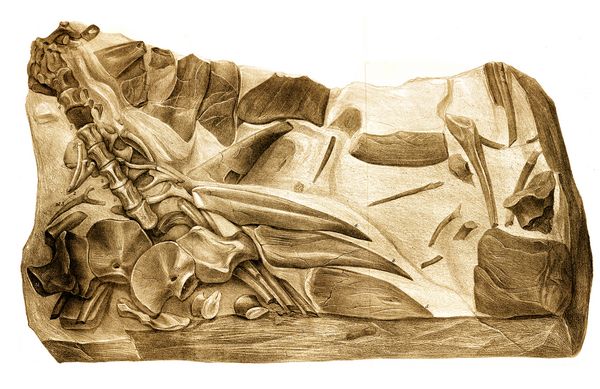Athena Review Image Archive ™
Hylaeosaurus armatus Mantell

Hylaeosaurus armatus Mantell (after Erxleben 1858)
Hylaeosaurus armatus
was a plant-eating Early Cretaceous dinosaur discovered by Gideon
Mantell in 1832. As such, it was one of the first dinosaur taxa to be
identified. Hylaeosaurus ("forest
lizard"), who lived during the Valinginian stage (136-137 mya) of
the Early Cretaceous period, was an armored dinosaur (ankylosaur) about
five meters long.
Its fossils were first discovered by Mantell in 1832 in Tilgate Forest in West Sussex, where a quarry face revealed about 50 bones of a saurian (see figure). The geological context was within the Early Cretaceous Grinstead Clay Formation, part of the Wealdon Formation dated at about 137 mya.
The type species, Hylaeosaurus armatus, was an herbivore with protective armor plates, and at least three long spines on its shoulder and shorter spines at the side of its neck. The original specimen of Gideon Mantell was later acquired by the Natural History Museum of London (cat. NHMUK 3775).
Mantell
bought the fossil fragments from a local dealer, then was able to
reconstruct them as a partial skeleton. The assembled fossils,
comprising the holotype of Hylaeosaurus,
included the rear of the skull and portions of the lower jaw, ten
vertebrae, both scapulae, both coracoids and several spikes and armour
plates. This represented the most complete dinosaur skeleton known at
that time, and the first described armored dinosaur or
ankylosaurian.
On December 5, 1832 Mantell reported the find of Hylaeosaurus
to the Geological Society of London. On the advice of his friend
Charles Lyell, Mantell published in 1833 a book on his fossil
finds with a chapter on Hylaeosaurus. The book, entitled The Geology of the South-East of England, named the type species as Hylaeosaurus armatus, currently considered the only valid species in the genus.
Meanwhile, Richard Owen, in his 1842 paper introducing the Dinosauria, actually credited himself and Georges Cuvier with Iguanodon's
discovery, while excluding any credit for Mantell, who had worked
for years accumulating fossils in order to establish the new
genus.
References:
Mantell, G.A. 1833. The Geology of the South-East of England. Longman Ltd., London
Mantell, G.A., 1841. Memoir on a portion of the lower jaw of the Iguanodon and on the remains of the Hylaeosaurus and other saurians, discovered in the strata of Tilgate Forest, in Sussex, Philosophical Transactions of the Royal Society of London, 131: 131–151
Owen, R. 1842
Copyright © 1996-2020 Rust Family Foundation (All Rights Reserved).